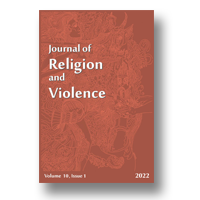|
|
|
1.
|
Journal of Religion and Violence:
Volume >
2 >
Issue: 3
James R. Lewis
Introduction
view |
rights & permissions
| cited by
|
|
|
|
|
articles |
|
2.
|
Journal of Religion and Violence:
Volume >
2 >
Issue: 3
Matthew Rowley
What Causes Religious Violence?:
Three Hundred Claimed Contributing Causes
abstract |
view |
rights & permissions
| cited by
Violence in the name of God is a complex phenomenon and oversimplification further jeopardizes peace because it obscures many of the causal factors. This paper categorizes three hundred scholarly claimed causes of religious violence and then offers thirteen guidelines for navigating the complicated relationship between religion and violence. Understanding this complexity is an important step towards diagnosing the problem and moving towards reconciliation.
|
|
|
|
|
3.
|
Journal of Religion and Violence:
Volume >
2 >
Issue: 3
Laerke Recht
Symbolic Order:
Liminality and Simulation in Human Sacrifice in the Bronze-Age Aegean and Near East
abstract |
view |
rights & permissions
| cited by
This paper examines engagement with live and dead human bodies through rituals involving human sacrifice in the ancient Aegean and Near East. After a review of the most significant archaeological contexts, properties of liminality and the manipulation of human remains for various types of staging are discussed.
|
|
|
|
|
4.
|
Journal of Religion and Violence:
Volume >
2 >
Issue: 3
Kamalroop Singh
Save Our Girls:
The Prevention of Female Foeticide in the Asian Community
abstract |
view |
rights & permissions
| cited by
An Oxford University study by Dubuc has found that an increasing number of Indian women in the UK are aborting their female foetuses, in order to have more boys. Research has found that over 1500 girls have ‘gone missing’ from birth statistics in England and Wales since the 1990s. The research concluded that the proportion of boys over girls has increased abnormally over time. This abnormal growth has been described as a result of ‘Sex Selective Abortion.’ This is only preliminary research and health experts consider the problem to be much larger. The reasons for aborting female foetuses are varied, but generally some families still follow the dowry system while others favour males to carry on the family name, and others see women as inferior. A number of Health authorities in the UK refuse to tell the sex of an unborn child, so some British Indian women travel to India to abort female foetuses. There is a lack of awareness about this unethical practice in the UK, and this could also be a large contributing factor. My paper will explore what the Sikh tradition has said about this practice, in particular from Sikh scripture and the rahitnāme from around the eighteenth century.
|
|
|
|
|
5.
|
Journal of Religion and Violence:
Volume >
2 >
Issue: 3
Birgit Pfeifer, Ruard R. Ganzevoort
The Implicit Religion of School Shootings:
Existential Concerns of Perpetrators Prior to Their Crime
abstract |
view |
rights & permissions
| cited by
The present paper explores which existential concerns emerge in autobiographical documents of school shooters. The perpetrators in this study discuss their hatred of humanity and existential loneliness in their video manifestos, suicide letters, or diary entries. These expressions—called leaking—contain traces of implicit religion which help us to understand strong layers of meaning in this seemingly irrational behavior. The study involves a narrative analysis of the expressions of school shooters to shed more light on the existential dimension of their motives. We discuss the relation between implicit religion and school shootings, with particular attention to religious terminology in shooters’ language.
|
|
|
|
|
6.
|
Journal of Religion and Violence:
Volume >
2 >
Issue: 3
Davis Brown
The Permissive Nature of the Islamic War Ethic
abstract |
view |
rights & permissions
| cited by
The Islamic war ethic of today is a tension between the ethic of necessary (even required) self-defense and something more militaristic. The Islamic war ethic is fundamentally permissive in two ways. First, the causes for self-defense are construed more broadly than causes for defense in other religious war ethics or in secular jus ad bellum. Second, classical Islam recognizes a prerogative of offensive war to eradicate polytheism and secure Islamic dominion. Empirical evidence suggests that this permissive war ethic influences the preferences of Muslim states for war or peace. Compared to non-Muslim states, and especially to Christian states, Muslim states have a higher propensity to initiate armed conflicts with other states.
|
|
|
|
|
book reviews |
|
7.
|
Journal of Religion and Violence:
Volume >
2 >
Issue: 3
Tim Rackett
Buddhist Fury: Religion and Violence in Southern Thailand. By Michael K. Jerryson
view |
rights & permissions
| cited by
|
|
|
|
|
8.
|
Journal of Religion and Violence:
Volume >
2 >
Issue: 3
Murray Haar
The Peace and Violence of Judaism: From the Bible to Modern Zionism. By Robert Eisen
view |
rights & permissions
| cited by
|
|
|
|
|
9.
|
Journal of Religion and Violence:
Volume >
2 >
Issue: 3
Laura Randall
In Kashmir: Gender, Militarization and the Modern Nation-State. By Seema Kazi
view |
rights & permissions
| cited by
|
|
|
|
